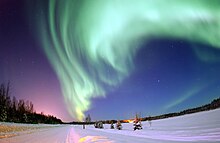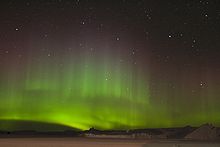"Aurora Borealis" redirects here. For other uses, see Aurora Borealis (disambiguation).
"Aurora Australis" redirects here. For the ship, see Aurora Australis (icebreaker). For the book, see Aurora Australis (book).
"Northern lights" redirects here. For the novel, see Northern Lights (novel).
For other uses, see Aurora (disambiguation).

False color DMSP image looking down from 850 km altitude showing discrete aurora (yellow) north of Scandinavia. Clouds and fog are blue.
In northern latitudes, the effect is known as the aurora borealis (or the northern lights), named after the Roman goddess of dawn, Aurora, and the Greek name for the north wind, Boreas, by Pierre Gassendi in 1621.[5] Auroras seen near the magnetic pole may be high overhead, but from farther away, they illuminate the northern horizon as a greenish glow or sometimes a faint red, as if the Sun were rising from an unusual direction. The aurora borealis most often occurs near the equinoxes. The northern lights have had a number of names throughout history. The Cree call this phenomenon the "Dance of the Spirits". In Europe, in the Middle Ages, the auroras were commonly believed a sign from God (see Wilfried Schröder, Das Phänomen des Polarlichts, Darmstadt 1984).
Its southern counterpart, the aurora australis (or the southern lights), has almost identical features to the aurora borealis and changes simultaneously with to changes in the northern auroral zone [6] and is visible from high southern latitudes in Antarctica, South America and Australia.
Aurorae occur on other planets. Similar to the Earth's aurora, they are visible close to the planet's magnetic poles.
Modern style guides recommend that the names of meteorological phenomena, such as aurora borealis, be uncapitalized.[7]
[edit] Auroral mechanism
Auroras result from emissions of photons in the Earth's upper atmosphere, above 80 km (50 miles), from ionized nitrogen atoms regaining an electron, and oxygen and nitrogen atoms returning from an excited state to ground state. They are ionized or excited by the collision of solar wind and magnetospheric particles being funneled down and accelerated along the Earth's magnetic field lines; excitation energy is lost by the emission of a photon of light, or by collision with another atom or molecule:- oxygen emissions
- Green or brownish-red, depending on the amount of energy absorbed.
- nitrogen emissions
- Blue or red. Blue if the atom regains an electron after it has been ionized. Red if returning to ground state from an excited state.
This is why there is a colour differential with altitude; at high altitude oxygen red dominates, then oxygen green and nitrogen blue/red, then finally nitrogen blue/red when collisions prevent oxygen from emitting anything. Green is the most common of all auroras. Behind it is pink, a mixture of light green and red, followed by pure red, yellow (a mixture of red and green), and lastly pure blue.
Auroras are associated with the solar wind, a flow of ions continuously flowing outward from the Sun. The Earth's magnetic field traps these particles, many of which travel toward the poles where they are accelerated toward Earth. Collisions between these ions and atmospheric atoms and molecules cause energy releases in the form of auroras appearing in large circles around the poles. Auroras are more frequent and brighter during the intense phase of the solar cycle when coronal mass ejections increase the intensity of the solar wind.[8]













Tidak ada komentar:
Posting Komentar